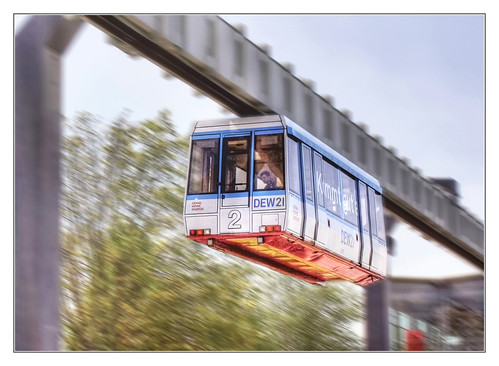Dortmund – H-Bahn
Dortmund – H-Bahn

Image by Daniel Mennerich
The H-Bahn ("Hängebahn", or "hanging railway") in Dortmund and Düsseldorf is a suspended, driverless passenger suspension railway system. The system was developed by Siemens, who call the project SIPEM (SIemens PEople Mover).
Two installations exist, one at the Dortmund university campus, the other at the Düsseldorf Airport. While Siemens is no longer actively marketing the system, and will no longer carry out turnkey projects, new installations are still possible in collaboration with the Dortmund operating company.
Since 2011 Air Train International has been marketing the system in China and as of May 2013 there are proposals to build lines in Shanghai and Wenzhou. A number of other Chinese cities are also studying the system.
The first publicly funded overhead railway has run since 1984 at the University of Dortmund, where it initially just connected the north and south campuses. This stretch was opened on 2 May 1984 by Dr. Heinz Riesenhuber, and comprised 1.05 kilometres (0.65 mi) of track and two trains. The cost was approximately DM 24,000,000 (€12,270,000), of which 75% was funded by the German Federal Government, 20% by the state of North Rhine-Westphalia and 5% by the city of Dortmund.
The longest span between support pillars is 38.5 metres (126.3 ft), where it crosses the university road, which bisects the two campuses. Just beyond the road the H-Bahn crosses through a nature reserve at its maximum elevation of about 16 metres (approx. 50 feet) above ground. In order to prevent passengers getting close to the track at stations, there are platform edge doors between the platform and the track. As soon as the vehicles arrive in the station, doors in the partition open automatically, along with the train car doors.
In 1993, following a three-year construction period, a new 900 m (0.56 mile) long branch was opened, along with two new stations, one in Eichlinghofen and another at the S-Bahn station at Dortmund university. This construction included technology considered to be the first of its kind in Germany. The existing system was renovated, and equipped with technology which allowed determining the train’s location with a much higher precision — within 3 cm (1.2 in). These changes allowed for a higher speed, and trains can now also follow each other more closely. Three new carriages were supplied by Siemens. An extension into the nearby technology park was opened on 19 December 2003, which means the current network, including this final 1.2 km (0.75 mi) extension, has a length of 3.162 km (approx. 2 miles). The building of this section cost around €15,500,000.
Line 1 operates between the Technology Park and Eichlinghofen, and during the day carriages arrive every ten minutes, stopping at the university and the S-Bahn stop, where there is a connection every twenty minutes to Dortmund city centre, and Bochum. Two trains serve line 1.
Line 2 is the original line between the North and South campuses of the university, and is served by a third train. A reserve fourth vehicle is available, and there is also a maintenance vehicle.




